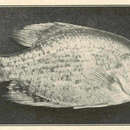en
names in breadcrumbs


Perception Channels: tactile ; chemical
Pomoxis nigromaculatus is not among those species in the endangered species list; however, to avoid over-fishing, daily limits are used.
US Federal List: no special status
CITES: no special status
State of Michigan List: no special status
Since black crappie are omnivorous, they eat the fingerlings of many other fish, including those of its predators: pike, walleye, muskellunge, etc. If there are no predators for smaller fish such as sunfish, perch, and black crappie, the lake will become over populated. This tendency for black crappie to overpopulate its community, not only stunts its species' population growth, but also those of other species due to an increase in competition. (Becker 1983)
Pomoxis nigromaculatus is a popular sport fish: the flesh is white and flaky; due to its wide variety of prey, fisherman are able to use many methods to catch them; they can be caught at all times of the year, which especially benefits fishermen who enjoy ice-fishing; high populations allow for many to be caught; and their aggressiveness allows for a good fight. (Sigler et al. 1987, Becker 1983)
As a juvenile, Pomoxis nigromaculatus feeds mainly on microscopic prey such as Cyclops, Cladocera, and Daphnia.
As an adult, Pomoxis nigromaculatus is a mid-water omnivore that feeds in vegetation and open water. Its numerous gill rakers allow it to consume planktonic crustaceans; however aquatic insects, minnows, and fingerlings of other species comprise its main diet. Dawn, noon, dusk, and midnight are peak times for black crappie feeding.
Much of the success of the black crappie is attributed to its ability to eat foods of all forms, at all times of the year. (Becker 1983)
The native range of Pomoxis nigromaculatus is the freshwaters of central and eastern North America. It has further been introduced to freshwater lakes of the Pacific coast and Canada due to its popularity as a sport-fish and its durability. (Mettee et al. 1996, Sigler et al. 1987)
Biogeographic Regions: nearctic (Introduced , Native )
Pomoxis nigromaculatus favors clear, warm, highly vegetated, moderately acidic, and non-turbid waters of lakes and rivers in its natural range. (Sigler et al. 1987)
Aquatic Biomes: lakes and ponds; rivers and streams
Average lifespan
Status: wild: 10.0 years.
Average lifespan
Status: captivity: 12.0 years.
Average lifespan
Status: wild: 13.0 years.
Black crappie adults vary from 130-381 mm in length. The average weight varies from 0.25-0.90 kg. Black crappie are a monomorphic species characterized by 7-8 dorsal spines which are stepped in length, an upturned (S-shaped) snout, symmetrical dorsal and anal fins, a wavy light and dark pattern on non-paired fins, and a mottled (spotty) color pattern.
There are color variances among populations of black crappie. Age, habitat, and breeding are all determinants of the intensity and patterns of mottling: juveniles tend to have less pigment and pattern than adults; those black crappie living in clear, vegetated water have strikingly bolder patterns than those living in turbid, murky water; and breeding males have a darker head and breast than normal populations. (Jenkins et al. 1994, Sigler et al. 1987, Trautman 1981, Becker 1983, Smith 1979, Robison et al. 1988, Mettee et al. 1996)
Range mass: 250 to 900 g.
Average mass: 0.57 g.
Other Physical Features: bilateral symmetry
Both sexes of Pomoxis nigromaculatus reach their sexual maturity by the age of two and usually live seven years. The spawning temperatures and months vary due to the wide natural range of black crappie, but the temperatures are usually from 58° to 68° Fahrenheit, corresponding to the months of April through June.
Before the spawning period, black crappie form schools that migrate to shallower water to feed. It is during schooling when the male crappie sweeps out the nests and attracts the female. The female black crappie is very fertile. She may spawn several times during the period with several males, bearing 10,000-200,000 eggs (variation related to size and age of female). Once the eggs are in the nest, it is the male's responsibility to guard the nest until the young can freely swim and feed. (Jenkins et al. 1994, Sigler et al.1987, Becker 1983, Robison et al. 1988, Mettee et al. 1996)